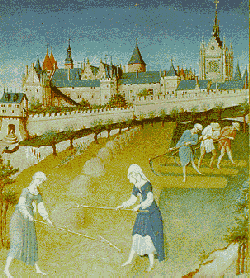
Medieval Times
Traditions
[Home]

Medieval Times
In medieval times a festival of egg throwing was held in church, during which the priest would throw a hard-boiled egg to one of the choirboys. It was then tossed from one choirboy to the next and whoever held the egg when the clock struck 12 was the winner and retained the egg.
The first Easter baskets were made to look like bird's nests.
Easter Bonnets are a throw back to the days when the people denied themselves the pleasure of wearing finery for the duration of Lent.

A painted Easter Egg
The traditional act of painting eggs is called Pysanka.
To Egyptians, the egg was a sacred token of the renovation of mankind after the Flood.
The egg has always been a symbol of the Resurrection to Christians.
The date of Passover is variable as it is dependent on the phases of the moon, and thus Easter is also a movable feast.
The custom of giving eggs at Easter time has been traced back to Egyptians, Persians, Gauls, Greeks and Romans, to whom the egg was a symbol of life.
Every year at Easter Pope John Paul sends his " Urbi et Orbi " to the world.
Easter is now celebrated (in the words of the Book of Common Prayer) on the first Sunday after the full moon which happens on or after March 21, the Spring Equinox.
Some Churches still keep up the old tradition of using evergreens - symbolic of eternal life - embroidered in red on white, or woven in straw, but most now prefer displays of flowers in the spring colours of green, yellow and white.
In the United States Easter is celebrated with a large Easter Egg-Hunt by children on the White House Lawn.
To the Jews, the egg marked the time of their departure from the land of Egypt.
By tradition, it was obligatory (or at least lucky) for churchgoers to wear some bright new piece of clothing - at least an Easter bonnet, if not a complete new outfit.